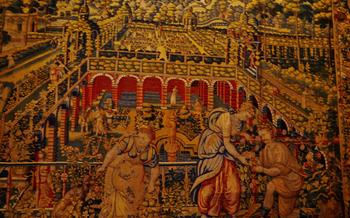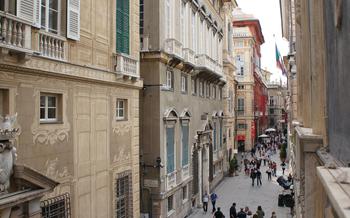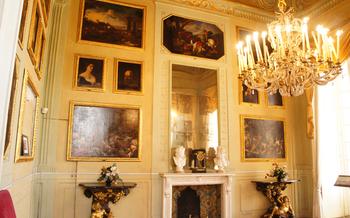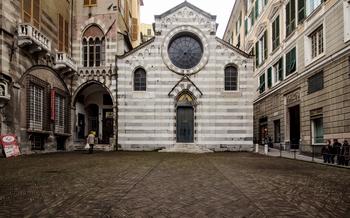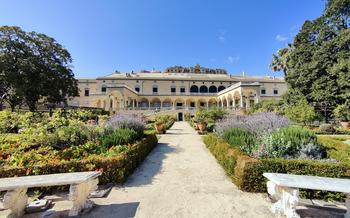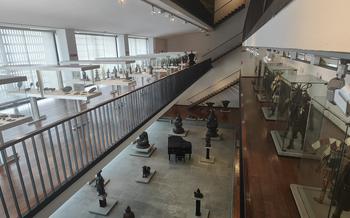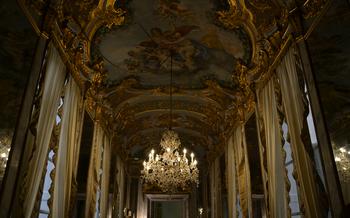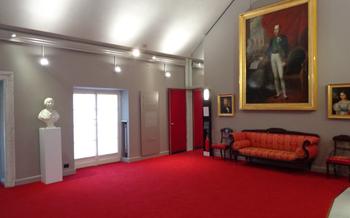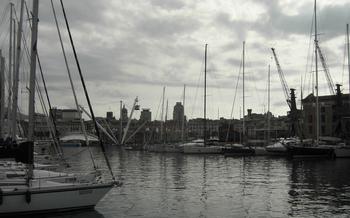
Palazzo Doria Tursi
- Historical Significance
- Architectural Marvel
- Public Palace
- Exploring the Palazzo
- Grand Hall
- Art and Frescoes
- Ornate Staircases
- Throne Room
- Hall of Mirrors:
- Secret Gardens
- Cultural Events: A Platform for Art and Dialogue
- Changing of the Guard
- Surrounding Area
- Insider Tip:
Historical Significance
The Palazzo Doria Tursi stands as a testament to the grandeur and influence of the Doria family, one of Genoa's most prominent and powerful families. The Doria family played a pivotal role in shaping the city's maritime, political, and economic landscape during the 16th and 17th centuries. Their association with the palace began in the mid-1500s when Nicolò Doria, a wealthy merchant and statesman, acquired the property. Over the years, the palace underwent several renovations and expansions under the stewardship of successive generations of the Doria family, transforming it into a magnificent symbol of their wealth and prestige.
The palace's historical significance extends beyond its connection to the Doria family. In 1821, the palace was purchased by the Municipality of Genoa and became the seat of the city government. This marked a new chapter in the palace's history, transitioning from a private residence to a public edifice serving the people of Genoa. Today, the Palazzo Doria Tursi remains a symbol of Genoese pride and civic identity, housing the offices of the Mayor, the City Council, and various municipal departments.
Architectural Marvel
The Palazzo Doria Tursi stands as a testament to the grandeur and architectural prowess of the Genoese. Its imposing facade, adorned with intricate carvings and sculptures, captivates the eye. The palace's exterior showcases a harmonious blend of various architectural styles, reflecting the city's rich history. The grand entrance, flanked by majestic columns, leads visitors into a world of opulence and artistry.
Inside, the palace's opulent interiors are a feast for the senses. The grand halls and galleries are adorned with intricate frescoes, tapestries, and paintings by renowned artists, each masterpiece contributing to the palace's rich artistic heritage. The vaulted ceilings, embellished with elaborate stucco work and gleaming chandeliers, create an atmosphere of awe-inspiring grandeur.
Notably, the palace's courtyards offer a delightful contrast to the ornate interiors. These tranquil spaces, surrounded by elegant arcades and lush greenery, provide a serene oasis amidst the bustling city. The interplay of light and shadow, as the sun filters through the trees, casts a magical glow upon the palace's facades, creating a picturesque scene that leaves visitors spellbound.
Public Palace
The Palazzo Doria Tursi underwent a significant transformation in the mid-19th century when it transitioned from a private residence to a public building. This shift marked a new chapter in the palace's history, as it became the seat of the Municipality of Genoa. The decision to house the city's administrative offices within the palace reflected its growing importance as a civic and political center.
Today, the Palazzo Doria Tursi stands as a symbol of Genoa's rich heritage and its enduring commitment to public service. As the seat of the Municipality, the palace plays a crucial role in shaping the city's policies, initiatives, and urban development. It serves as a venue for official meetings, ceremonies, and events that bring together local government officials, citizens, and visitors.
The transition of the Palazzo Doria Tursi from a private palace to a public building reflects the evolving nature of Genoa itself. Once a powerful maritime republic, Genoa has grown into a modern metropolis with a vibrant political and cultural landscape. The palace's transformation mirrors this evolution, showcasing the city's ability to adapt and thrive while preserving its historical legacy.
Exploring the Palazzo
Visiting the Palazzo Doria Tursi is a journey through history and art. The palace welcomes visitors with open arms, inviting them to explore its grandeur. Guided tours are available for those who wish to delve deeper into the palace's stories and secrets. These tours offer insights into the palace's history, architecture, and art, providing a comprehensive understanding of this magnificent building.
For those who prefer to wander at their own pace, self-guided exploration is another option. Visitors can stroll through the palace's rooms, admiring the intricate decorations, opulent furnishings, and stunning works of art. Interactive displays and information panels enhance the experience, offering additional context and historical insights.
Whether opting for a guided tour or self-exploration, visitors are encouraged to take their time and savor the beauty of the Palazzo Doria Tursi. Each room holds its own unique charm, from the grand halls to the intimate chambers. The palace is a testament to Genoa's rich history and artistic heritage, and exploring it is a truly enriching experience.
Grand Hall
The Grand Hall, or Salone del Maggior Consiglio, is the heart of the Palazzo Doria Tursi and one of the most impressive spaces in Genoa. Once the seat of the Grand Council of the Republic of Genoa, this majestic hall has witnessed countless historical events and decisions that shaped the city's destiny.
With its soaring ceiling adorned with intricate frescoes, marble-floored expanse, and rows of ornate wooden benches, the Grand Hall exudes an aura of grandeur and solemnity. The walls are lined with portraits of notable Genoese citizens, adding to the hall's sense of history and civic pride.
Today, the Grand Hall primarily serves as a venue for important ceremonies, conferences, and cultural events. It is also open to the public for guided tours, allowing visitors to step back in time and experience the grandeur of this historic space.
Art and Frescoes
The Palazzo Doria Tursi is a treasure trove of artistic masterpieces and frescoes that captivate visitors with their beauty and historical significance. Among the notable works of art is the impressive collection of paintings by renowned artists such as Luca Cambiaso, Bernardo Strozzi, and Giovanni Benedetto Castiglione. Their works adorn the walls of various rooms and halls, depicting biblical scenes, mythological tales, and portraits of prominent figures from Genoese history.
One of the highlights of the palace's artistic collection is the series of frescoes by Domenico Fiasella in the Salone del Maggior Consiglio. These stunning frescoes depict scenes from Genoese history and mythology, bringing to life the city's rich past and legends. The vibrant colors and intricate details of the frescoes are a testament to Fiasella's mastery as an artist.
Another notable work of art is the fresco by Giovanni Andrea Ansaldo in the Sala del Doge, which depicts the "Entry of Andrea Doria into Genoa." This fresco commemorates the triumphant return of the Genoese admiral, Andrea Doria, after his victory over the French in 152The fresco captures the jubilation and pride of the Genoese people as they welcome their hero back to the city.
In addition to these major works, the Palazzo Doria Tursi is adorned with numerous other frescoes and paintings by talented artists from different periods. These works contribute to the palace's rich artistic heritage and provide a glimpse into the artistic and cultural climate of Genoa throughout the centuries.
Ornate Staircases
The Palazzo Doria Tursi is renowned for its magnificent staircases, particularly the monumental Scala Maggiore. This grand staircase, designed by Bartolomeo Bianco, sweeps up from the courtyard to the piano nobile, creating a breathtaking visual spectacle. Its elegant curves, intricate ironwork balustrades, and opulent marble steps contribute to the palace's overall grandeur. The Scala Maggiore served as a ceremonial pathway for guests arriving at the palace for official functions and receptions. Its architectural significance lies in its perfetta simmetria (perfect symmetry), which was a defining feature of Renaissance architecture. The staircase's aesthetic appeal is further enhanced by the play of light and shadow, creating a dramatic effect that leaves visitors in awe.
Throne Room
The Throne Room, or Sala del Doge, is a magnificent chamber within the Palazzo Doria Tursi. It served as the official reception room for the Doge, the highest-ranking official in the Republic of Genoa. This grand hall exudes an aura of power and opulence, reflecting the Doge's authority and prestige.
The Throne Room is adorned with intricate frescoes and opulent furnishings, creating a truly regal atmosphere. The walls are adorned with vibrant depictions of historical events and allegorical scenes, showcasing the artistic talents of renowned painters. The ceiling is adorned with a breathtaking fresco, adding to the room's grandeur.
At the far end of the room, an elevated platform dominates the space. Here, the Doge would sit upon his ornate throne, surrounded by his advisors and officials. The throne, an exquisite work of art in itself, is a symbol of the Doge's authority and the power he wielded.
The Throne Room has witnessed countless historical events, from grand receptions and diplomatic negotiations to solemn ceremonies and official proclamations. It is a place where history unfolds, where decisions were made that shaped the fate of Genoa and its people.
Hall of Mirrors:
The Hall of Mirrors, also known as the Sala degli Specchi, is one of the most visually stunning rooms in the Palazzo Doria Tursi. The room's name aptly captures its defining feature—a series of large mirrors that adorn the walls. These mirrors, along with the opulent décor, create an illusion of grandeur and spaciousness. The ceiling is adorned with intricate frescoes, further enhancing the room's magnificence. The Hall of Mirrors exudes an aura of luxury and sophistication, making it a popular venue for official receptions, ceremonies, and social gatherings. Step into this room to immerse yourself in its grandeur and history, and experience the lavish lifestyle of Genoa's elite during the Renaissance and Baroque periods.
Secret Gardens
Amidst the grand halls and opulent interiors, the Palazzo Doria Tursi conceals a hidden gem—the Secret Gardens. These secluded havens offer a tranquil escape from the bustling city outside. Stroll through the verdant paths lined with fragrant flowers, admire the meticulously manicured lawns, and let the gentle sound of water fountains soothe your senses. Lose yourself in the serene atmosphere as you discover hidden corners adorned with sculptures and statues, each telling a unique story from the palace's rich history. The Secret Gardens provide a peaceful sanctuary to rejuvenate and reflect, while immersing yourself in the beauty of nature and art.
Cultural Events: A Platform for Art and Dialogue
The Palazzo Doria Tursi is not merely a historical monument; it continues to serve as a vibrant cultural hub for Genoa. Throughout the year, the palace hosts a diverse array of cultural events, exhibitions, and initiatives that cater to a wide range of interests. Art enthusiasts can marvel at rotating exhibitions showcasing works by renowned artists, both contemporary and classical. These exhibitions often delve into specific themes or periods, providing visitors with a deeper understanding of art history and artistic expression.
Moreover, the palazzo collaborates with cultural institutions and organizations to present conferences, seminars, and workshops on various topics related to art, history, and culture. These events offer a platform for discourse, intellectual exchange, and the exploration of new ideas. By actively engaging with the community, the Palazzo Doria Tursi fosters a sense of cultural dialogue and encourages the appreciation of diverse perspectives.
To stay informed about upcoming events, visitors can check the palace's official website or follow its social media channels. The website provides detailed information on each event, including dates, times, and admission fees. By planning ahead, visitors can ensure that they don't miss out on the opportunity to experience the rich cultural offerings of the Palazzo Doria Tursi.
Changing of the Guard
Every Saturday morning, visitors to the Palazzo Doria Tursi can witness the traditional Changing of the Guard ceremony that takes place just outside the palace. This colorful and solemn event showcases the changing of the guard responsible for protecting the Palazzo and symbolizing the continuity of Genoese traditions. The ceremony, which dates back centuries, involves the participation of two teams of guards in ornate uniforms, accompanied by the rhythmic beat of drums. The precision and discipline displayed by the guards, combined with the grandeur of their uniforms and the historic backdrop of the Palazzo, make this a memorable and photo-worthy spectacle. The Changing of the Guard ceremony is a unique opportunity to experience the rich cultural heritage and traditions of Genoa and is a must-see for anyone visiting the city.
Surrounding Area
The Palazzo Doria Tursi is situated in the heart of Genoa's historic center, surrounded by a wealth of other attractions and landmarks. Take advantage of your visit to explore the surrounding area and discover the city's rich history and culture. Stroll along the picturesque Via Garibaldi, renowned for its opulent Renaissance palaces, and admire the architectural masterpieces that line this grand street. Visit the nearby Piazza de Ferrari, the city's main square, and marvel at the majestic fountain and surrounding buildings. For art enthusiasts, the Palazzo Bianco and Palazzo Rosso, located just steps away, house impressive collections of paintings and sculptures from various periods. Genoa is also a culinary paradise, offering a diverse range of restaurants and cafes. Indulge in the local cuisine, savoring fresh seafood dishes and traditional Ligurian specialties. Take your time to wander through the narrow alleys, soak in the vibrant atmosphere, and uncover the hidden gems that Genoa has to offer.
Insider Tip:
To fully appreciate the grandeur of the Palazzo Doria Tursi and steer clear of the tourist throngs, plan your visit wisely. Avoid weekends and public holidays when the palace tends to be bustling with visitors. Instead, opt for a weekday morning, particularly during the shoulder seasons (spring and autumn). You'll encounter fewer crowds, allowing you to leisurely explore the palace's opulent halls and admire its artistic treasures without feeling rushed or overwhelmed. This tranquil ambiance will enhance your experience, enabling you to fully immerse yourself in the rich history and beauty that the Palazzo Doria Tursi has to offer.
